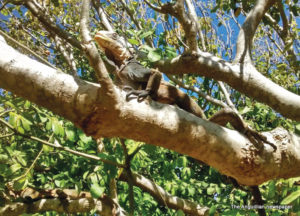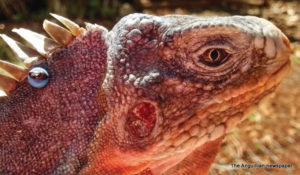 Last week, the European Union’s Voluntary Scheme for Biodiversity and Ecosystem Services in Territories of European Overseas (BEST) confirmed funding to the Anguilla National Trust (ANT), the St. Barths Territorial Environmental Agency (ATE), and the St. Eustatius National Parks (STENAPA). The grant for the three agencies will be used over 18 months to support native Lesser Antillean iguana research and conservation action.
Last week, the European Union’s Voluntary Scheme for Biodiversity and Ecosystem Services in Territories of European Overseas (BEST) confirmed funding to the Anguilla National Trust (ANT), the St. Barths Territorial Environmental Agency (ATE), and the St. Eustatius National Parks (STENAPA). The grant for the three agencies will be used over 18 months to support native Lesser Antillean iguana research and conservation action.
The project, led by the ANT in partnership with ATE, STENAPA, Durrell Wildlife Conservation Trust, Fauna & Flora International, and the University of Roehampton, builds on native iguana conservation initiatives already established on the three territories and seeks to coordinate and integrate action amongst the agencies and to build on individual experiences, strengths, and knowledge.
This project will establish a platform for strategic species conservation and protection for Anguilla’s, St. Barths, and Statia’s biodiversity, using the Lesser Antillean iguana as an example of how national priorities can be coordinated and can lead to long-term regional conservation benefits. This project provides opportunities for cross-territory learning, knowledge exchange, and capacity building as well as networking amongst front-line conservation agencies.
Activities planned under this European Union-funded project include: the creation of a sub-regional framework for native iguana species recovery and conservation; the building of local and regional knowledge and on native iguana populations; the reintroduction of additional native iguanas to Prickly Pear East; the development and implementation of standardised bio-security measures targeting the invasive green iguana in Anguilla, St. Barths, and Statia; the increasing of cross-territory expertise, and capacity and the enhancement of sub-regional partnerships and networks; and the increase in awareness and support for native iguana conservation.
The Endangered Lesser Antillean iguana is currently restricted to six island territories in the Lesser Antilles, including Anguilla, St. Barths, and Statia. On all islands on which it occurs, the species is under threat from habitat alteration, land development, predation by rats, cats, dogs, and humans, and, more recently (on most islands), the introduced common green iguana I. iguana. Studies from the region suggest that when green iguana are pr esent, the native iguana typically disappear within a few decades due to hybridization.
esent, the native iguana typically disappear within a few decades due to hybridization.
It is hoped that a regional approach to Lesser Antillean iguana conservation will be used as an example for future species conservation action and of how island territories and conservation agencies can work together to multiply conservation impact.
The ANT continues to appreciate the public’s assistance with its iguana conservation work and urges individuals to contact the Trust should an iguana be sighted – regardless of species. For more information about this European Union-funded project and Anguilla’s iguana species or to report an iguana sighting, individuals are encouraged to contact the Anguilla National Trust at 497 5297 or to visit the ANT office located next the Dental Clinic in The Valley.
– Press Release
(Published without editing by The Anguillian newspaper.)








